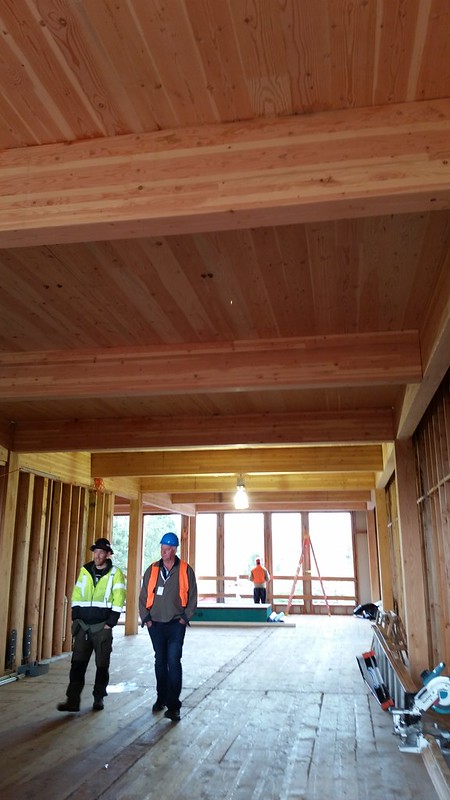Mass Timber Growth and Trends

A construction zone at a mass timber building site in Portland, OR in 2016
Latest Report from Dovetail Partners Addresses Mass Timber Growth and Trends
Written by Maria Golden and Kathryn (Katie) FernhoIz of Dovetail Partners. Katie is a long-time member and past board member of the Guild. Dovetail and the Guild partner on many efforts and members benefit from the research and information Dovetail shares nationwide. All photos are credit to Dovetail Partners.
In January 2016, Dovetail released a report addressing modern tall wood buildings. The report recognized that wood use in high-rise structures in the U.S. would likely increase in the coming years. Fast forward to 2022, Dovetail has released an updated report that summarizes the policy and code changes, names challenges mass timber might face in the future, and discusses developments related to mass timber constructions. One of the key takeaways in the new report is that mass timber construction in the U.S. and Canada has grown by 19% since 2019.
As of 2022, 1,400 mass timber projects have been constructed in the U.S. The tallest building is 25-stories. Mass timber manufacturing capacity has also grown. In the U.S. and Canada, mass timber manufacturing has increased from 4 to 11 companies since 2016, with 3 more planned.

The view from a mass timber constructed building in Portland, OR in 2016
While mass timber projects seemed like the way to go in 2016, there were policies and codes in place at that time that frequently limited building heights to only 5 or 6 stories (depending on the occupancy group). This changed in 2019 when the International Code Council (ICC) approved a set of proposals to allow tall wood buildings up to 18-stories as part of the 2021 International Building Code (IBC). Additional changes to be incorporated in the 2024 IBC include allowance for exposure of mass timber ceilings and integral beams. The 2021 IBC permitted these areas to have 20% exposure while the 2024 IBC will permit 100% exposure. For the IBC code changes to work, local jurisdictions still have to adopt the changes and the tall wood code provisions. As of 2022, only 8 U.S. states have adopted code changes for tall mass timber provisions.
A common concern with mass timber is ensuring growing demand doesn’t exceed the supply of sustainable forest products. Peer-reviewed research published in early-2022 concluded that even in the most aggressive mass timber demand scenario, forest growth in the U.S. continues to exceed harvest by 18%.[1] Another reason mass timber is a sustainable choice, is the potential for up to a 68% reduction in emissions impact from a whole life cycle analysis perspective of a mass timber building with a 60 year life span.[2] That’s the equivalent of avoiding the emissions of up to 20,000 barrels of oil.
The opportunity of tall wood and mass timber buildings is beginning to be realized and the adoption rate of mass timber has been enhanced by the results of research, product standardization, code provisions, expanded production capacities, and the leadership of many public and private sector organizations. The bottom line is that continued innovation is needed for hybrid buildings, workforce development, and improved circulation and sustainability of materials. Guild members can contribute to the sustainable growth of mass timber innovations by supporting the adoption of code changes in their states and communities, continuing to practice sustainable forestry for sustainable forest products, and connecting with architects, engineers, and other built-environment professionals that share our interests in connecting people and planet in reciprocal relationships.
[1] Comnick, Jeff, Luke Rogers, and Kent Wheiler. 2022. “Increasing Mass Timber Consumption in the U.S. and Sustainable Timber Supply” Sustainability 14, no. 1: 381. https://doi.org/10.3390/su14010381
[2] Perkins&Will, 2021. https://masstimberhousing.com/ whole-life-carbon
